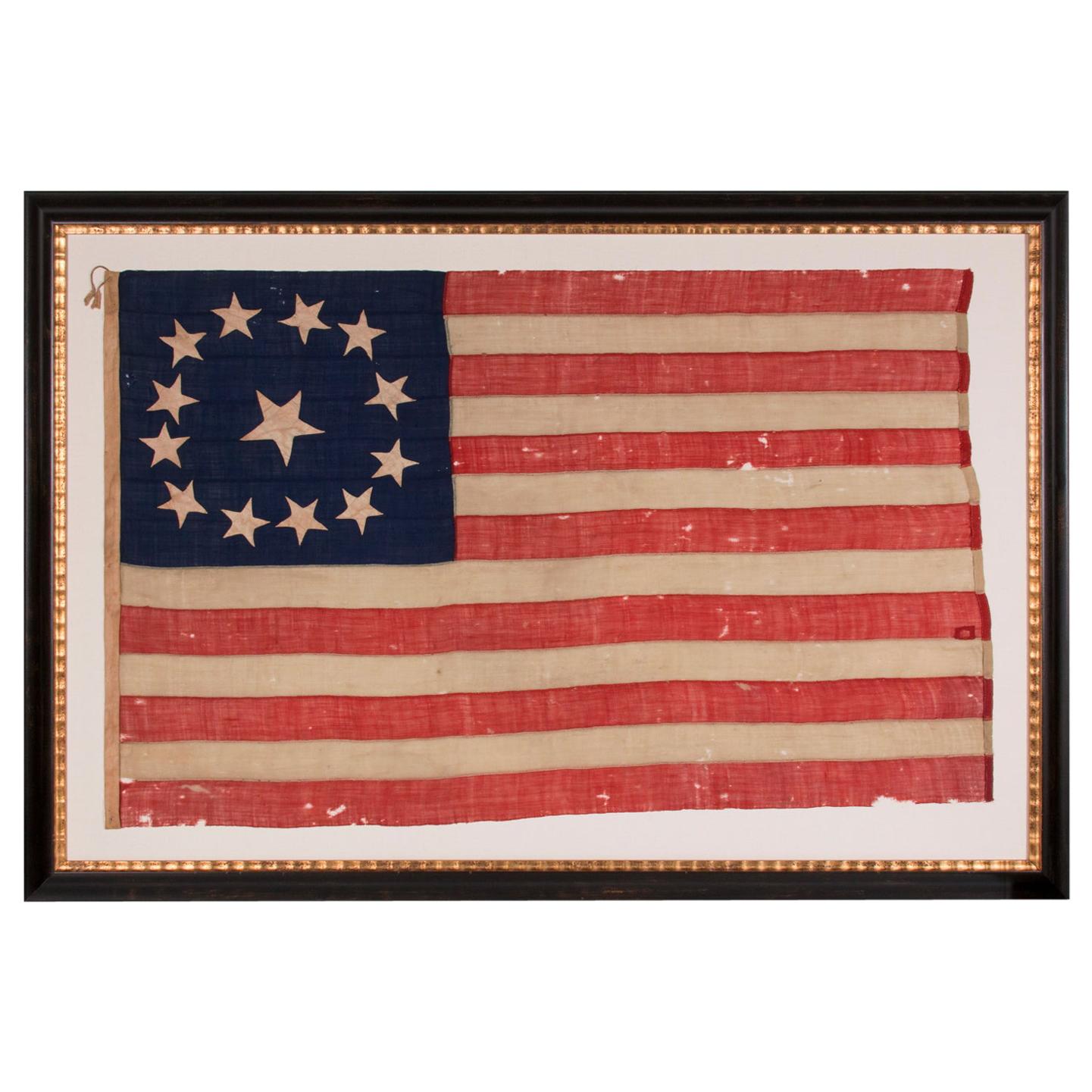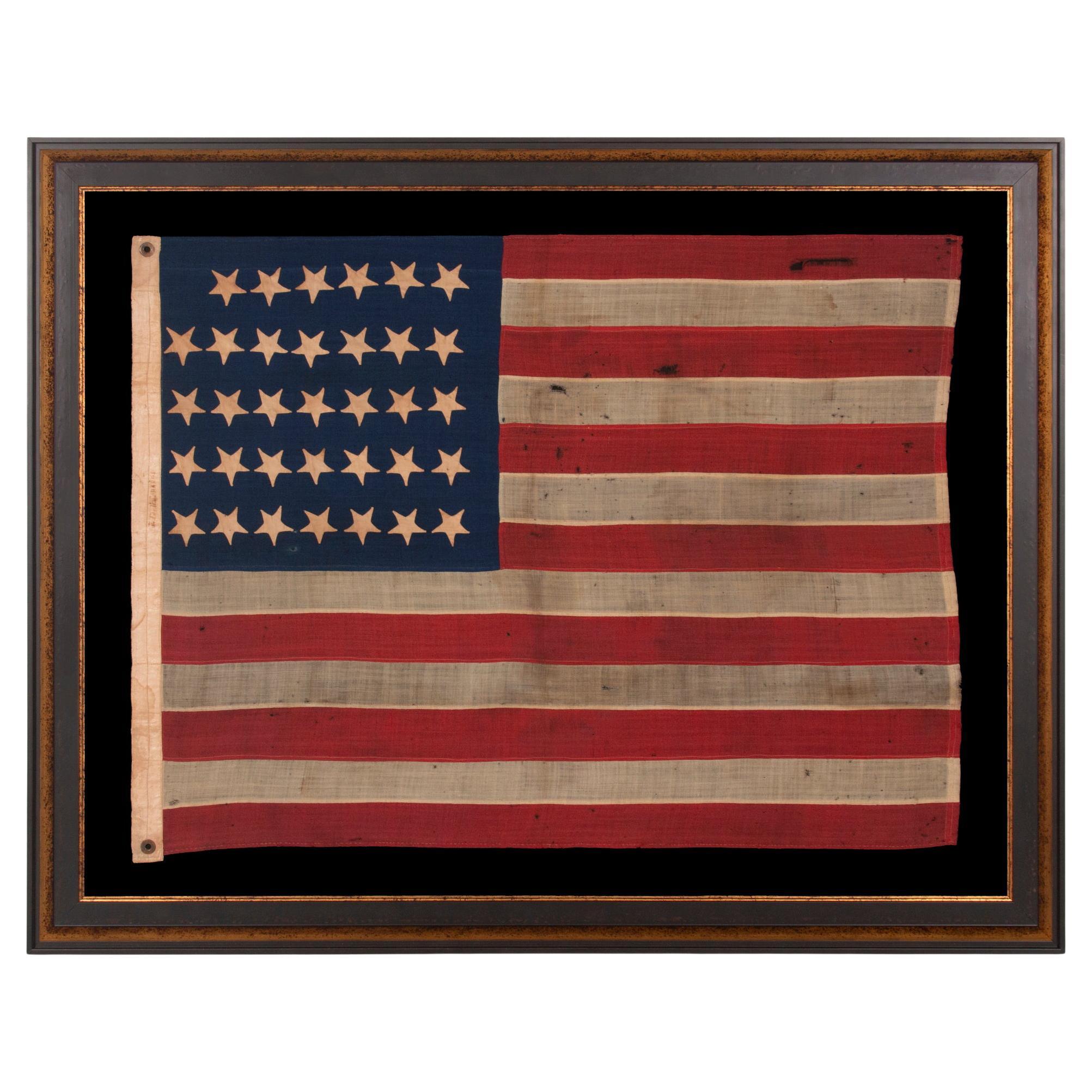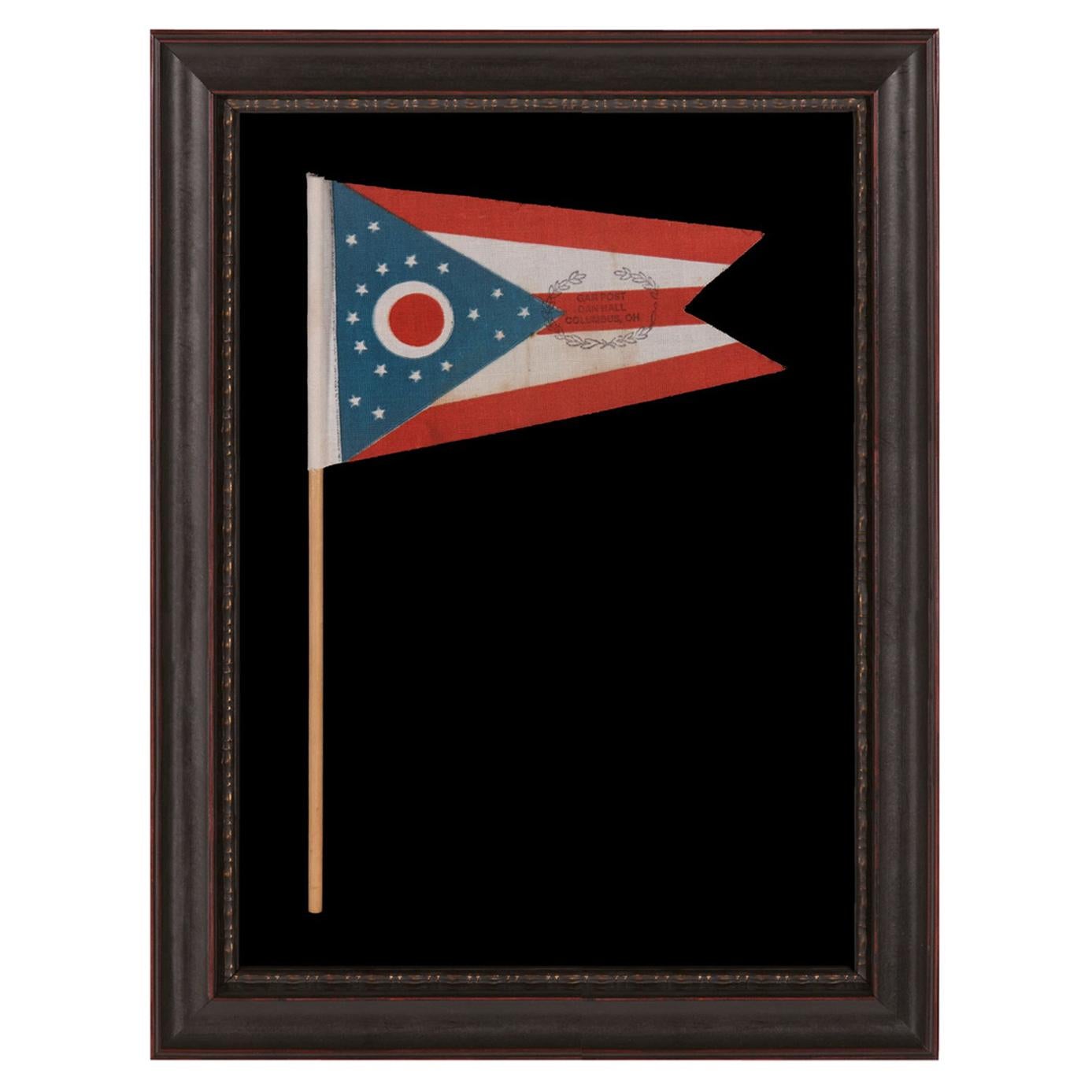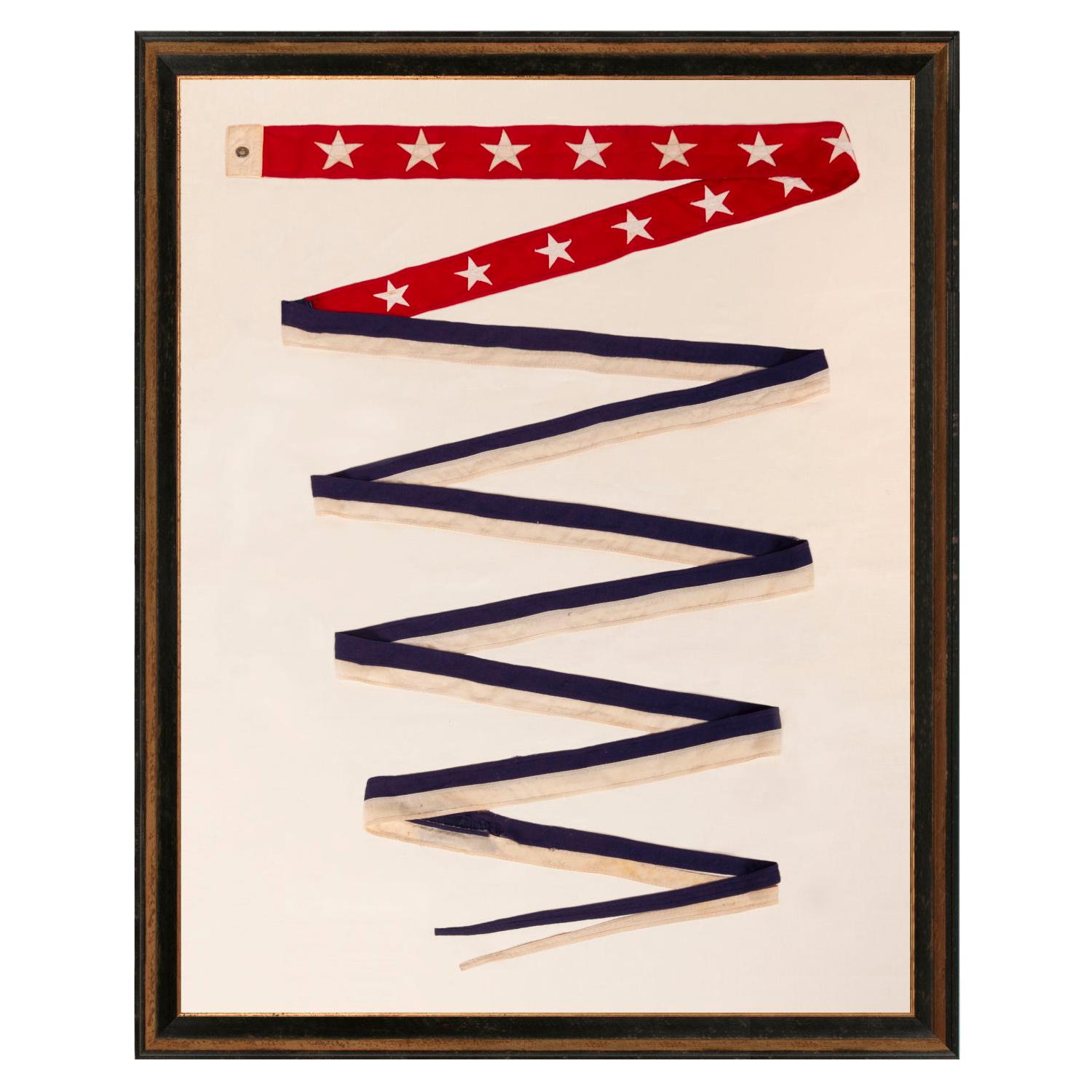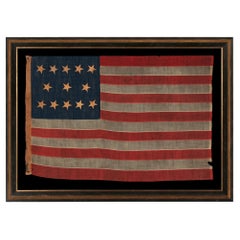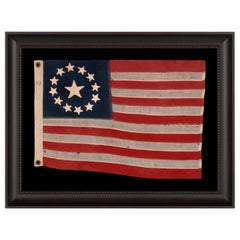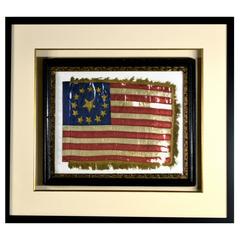
Rare 13 Star Civil War Flag with Gold Stars Hand Sewn
View Similar Items
1 of 5
Rare 13 Star Civil War Flag with Gold Stars Hand Sewn
About the Item
- Dimensions:Height: 31 in (78.74 cm)Width: 35 in (88.9 cm)Depth: 2 in (5.08 cm)
- Style:American Colonial (In the Style Of)
- Materials and Techniques:
- Place of Origin:
- Period:
- Date of Manufacture:1860
- Condition:Wear consistent with age and use. Minor losses. Minor structural damages. Minor fading. Nice condition for age wear and use in the field and 157 years old.
- Seller Location:Acworth, GA
- Reference Number:Seller: 161511stDibs: LU140526573253
You May Also Like
- 13 Star, 3rd MD Pattern, Hand-Sewn Antique American Flag, Civil War Era, 1861-65Located in York County, PA13 LARGE STARS WITH AN EVEN LARGER CENTER STAR, IN A CIRCULAR VERSION OF WHAT IS KNOWN AS THE 3RD MARYLAND PATTERN, ENTIRELY HAND-SEWN, MADE SOMETIME BETWEEN 1850 AND THE CIVIL WAR (...Category
Antique 1860s American Political and Patriotic Memorabilia
MaterialsWool
- 13 Star Antique American Flag with Hand-Sewn Stars in 5-3-5 Pattern, ca 1861-65Located in York County, PAAntique American flag with 13 hand-sewn stars in an extremely rare lineal configuration of 5-3-5, probably made with the intent of use by local militia or private outfitting of a vol...Category
Antique 1860s American Political and Patriotic Memorabilia
MaterialsWool
- 13 Star American Flag with Hand-Sewn Stars in the 3rd Maryland PatternLocated in York County, PA13 hand sewn stars in a circular version of what is known as the 3rd Maryland pattern, with an especially large center star, a flag with especially tiny scale among those with pieced-and-sewn construction, exceptionally rare, made circa 1890: 13 star flags have been flown throughout our nation’s history for a variety of purposes. They were hoisted at patriotic events, including Lafayette’s visit in 1824-25, the celebration of the centennial of American independence in 1876, and the sesquicentennial in 1926. They were displayed during the Civil War, to reference past struggles for American liberty and victory over oppression, and were used by 19th century politicians while campaigning for the same reason. As the number of stars grew with the addition of new states, it became more and more difficult to fit their full complement on a small flag. The stars would, by necessity, have to become smaller, which made it more and more difficult to view them from a distance as individual objects. The fear was that too many of them close together would become as one white mass and distort the ability to identify American ships on the open seas. Keeping the count low allowed for better visibility. For this reason the U.S. Navy flew 13 star flags on small boats. Some private ship owners mirrored this practice and flew 13 star flags during the same period as the Navy. Flag experts disagree about the precisely when the Navy began to revert to 13 stars and other low counts. Some feel that the use of 13 star flags never stopped, which seems to be supported by depictions of ships in period artwork. This was, of course, the original number of stars on the first American national flag, by way of the First Flag Act of 1777, and equal to the number of original colonies that became states. Any American flag that has previously been official remains so according to the flag acts, so it remains perfectly acceptable to fly 13 star flags today by way of congressional law. Since there was no official star configuration until the 20th century (1912 specifically, beginning with the 48 star count), the stars on 13 star flags may appear in any one of a host of configurations. Some of these are more rare and desirable than others. The stars of this particular flag are arranged in what has come to be known as the "3rd Maryland Pattern." This configuration, whether oval or circular, is appreciated both for its visual appeal and the scarcity of its use. a circular wreath of 12 with a single star in the center. The name comes from a flag that resides at the Maryland State Capitol in Annapolis, long thought to have been present with General Daniel Morgan at the Battle of Cowpens in 1781. According to legend, the flag was supposed to have been carried by Color Sergeant William Batchelor of the 3rd Maryland Light Infantry and was donated to the State of Maryland by Batchelor's descendants. The story was disproved in the 1970's, however, following an examination by the late flag expert Grace Rogers Cooper of the Smithsonian, who discovered that the Cowpens flag was, at the earliest, of Mexican War...Category
Antique 1890s American Political and Patriotic Memorabilia
MaterialsWool
Price Upon Request - 1862 Civil War Playing Cards with Stars, Flag, Sheilds and EaglesLocated in York County, PA1862 Civil War playing cards with stars, flags, shields, & eagles, and face cards illustrating civil war officers and lady, Columbia, ca 1862, Benjamin Hitchcock, New York 1862 Civil War playing cards with suits represented by stars, flags, shields, & eagles, in lieu of the traditional French suits of hearts, diamonds, clubs, and spades. The face cards feature Union Army officers and Lady Columbia [a.k.a. Lady Liberty, Goddess of Liberty]. Entitled “Union Playing Cards,” two versions of this deck were produced in New York by Benjamin W. Hitchcock’s “American Card Company.” This is the earlier of the two. The other was released in 1863. There are 52 cards in total with the ace of spades doubling as the title card, as was often the case during the 19th century. The telescoping box...Category
Antique 1860s American Political and Patriotic Memorabilia
MaterialsPaper
Price Upon Request - 34 Star Flag with Upside down Hand Sewn Stars, Kansas Statehood, ca 1861-1863Located in York County, PA34 Upside-down, Hand-sewn Stars In A Notched Configuration, On An Antique American Flag Of The Civil War Period, With A Beautiful And Highly Unusual Jacquard Weave Binding, And In A Tiny Scale Among Its Counterparts, Reflects The Addition Of Kansas As The 34th State, 1861-1863 34 star American national flag with a number of interesting and desirable features. Chief among these is the scale of the flag among counterparts of the period. At just three by four feet, its size is absolutely tiny among those with pieced-and-sewn construction. During the 19th century, sewn flags (as opposed to those that were printed on cloth) were typically eight feet long and larger. This is because they were important in their function as signals, meaning that they needed to be seen and recognized from great distance. A flag that was six feet in length was considered small and production of flags smaller than this was extremely limited. Even infantry battle flags, carried on foot, were approximately six by six and-one-half feet, about the size of an average quilt of the same period. It wasn't until the 1890’s that manufacturers began to produce smaller sewn flags in great quantity. The stars of the flag are arranged in justified lineal rows, the first of which contains one fewer star. This results in what I call a “notched” design, leaving one space open for the addition of another star. The blank space leaves little doubt that the maker of the flag assumed that another Western Territory would soon acquire statehood, or that West Virginia might soon break free from Virginia, which occurred in June of 1863. Note how the stars are oriented so that they are upside-down on their vertical axis, with two points up instead of one. No one knows if this positioning bore any particular meaning. Both modern notions of the correct orientation of a star, and the present official design of the American flag, dictate that the stars are supposed to have one point up. Since there was no official design for the flag until 1912, however, it may simply be that the maker of the flag did not consider any particular position to be right-side-up or upside-down. In the mid-19th century, it was not uncommon to see stars pointing any which way, varied throughout whatever arrangement was chosen. Whatever the case may be, the feature present on this particular flag is unusual to the eye and notable in terms of its presentation. Made of cotton, the stars are hand-sewn and double-appliquéd (applied to both sides). The canton and stripes of the flag are made of wool bunting. Because blue wool bunting generally came in a width of 18", the canton was pieced from two lengths of fabric, joined by hand-stitching. The canton is joined to the striped field by hand-stitching. The stripes are pieced and hemmed by treadle stitching. Made of heavy, polished, jacquard weave linen, the binding of the flag is both exceptional from a textile connoisseur’s perspective and highly unusual. This is joined to the flag by treadle stitching. There are two brass grommets, one each at the top and bottom of the hoist, which are likewise especially unusual, in that they are both heavier than normal and intentionally hammered flat. I have seen this on only one other occasion in a Civil War flag...Category
Antique Late 19th Century American Political and Patriotic Memorabilia
MaterialsWool
- 36 Star American Flag, Civil War Era, Nevada StatehoodLocated in York County, PA36 Stars In The "Great Star" Or "Great Luminary" Pattern On A Civil War Era Flag With A Dusty Blue Canton And A Section Of One Stripe Souvenired, 1864-67, Nevada Statehood 36 star American national flag of the Civil War era, entirely hand-sewn and with some rare and beautiful features. The stars are arranged in a rendition of what is known as the Great Star or Great Luminary configuration, a large star made out of smaller stars. With no official star pattern before 1912, their design was left up to the artistic liberties of the flag-maker. Strikingly visual, the Great Star is both scarce and coveted by collectors. The 36th state, Nevada, entered the Union during the Civil War on October 31st, 1864. The last Confederate general surrendered on May 26th, 1865. The 36 star flag became official on July 4th of that year, but makers of printed flags would have begun adding a 36th star to their flags in 1864, even before the addition of the new state occurred. Lincoln pushed Nevada through just 8 days before the November election. Nevada’s wealth in silver was attractive to a nation struggling with the debts of war and increased support for the Republican ticket. The 36 star flag was replaced by the 37 star flag in 1867, with the addition of Nebraska. Adding to the flag's appeal is its small scale across those with of piece-and-sewn construction. During the 19th century, sewn flags (as opposed to those that were printed on cloth) were typically eight feet long and larger. This is because they were important in their function as signals, meaning that they needed to be seen and recognized from great distance. A flag that was six feet in length was considered small and production of flags smaller than this was extremely limited. Even infantry battle flags were approximately six by six and-one-half feet, about the size of an average quilt of the same period. As time passed, circumstances changed and sewn flags began to find more of a decorative purpose. Smaller flags are more scarce and far easier to frame and display. The Great Star configuration appears to have come about shortly after the War of 1812, when Congressman Peter Wendover of New York requested that Captain Samuel Reid, a War of 1812 naval hero, create a new design that would become the third official format of the Stars & Stripes. A recipient of the Congressional Medal of Honor, Reid became harbor master of New York following the war. During his lifetime, he created many innovations in signal use, including a system that could actually send messages from New York to New Orleans by sea in just two hours. Use as a Naval signal had been the primary reason for the initial creation of an American national flag in 1777, but since there was no official star design, the appearance of our flag varied greatly. Reid’s primary concern centered on both consistency and ease of recognition. His hope was as more and more states joined the Union and more and more stars were added to the flag, that it would remain easily identified on the open seas. In 1818, Reid suggested to Congress that the number of stripes permanently return to 13 (reduced from 15) and that the stars be grouped into the shape of one large star. Reid’s proposal would have kept the star constellation in roughly the same format, in a pattern that could be quickly identified through a spyglass as the number of states grew. His concept for the stripes was ultimately accepted, but his advice on the star pattern was rejected by President James Monroe, due to the increased cost of arranging the stars in what would become known as the “Great Star”, “Great Flower”, or “Great Luminary” pattern. Monroe probably didn’t wish to impose this cost on either the government or civilians, so he suggested a simple pattern of justified rows. Never-the-less, the Great Star was produced by anyone willing to make it and its rarity today, along with its beauty, has driven the desirability of American flags with this configuration. The canton and stripes of the flag are made of fine merino wool. Note how the canton has faded to a dusty seafoam blue, which is endearingly attractive. The stars of the flag are hand-sewn and single-appliquéd. This means that they were applied to one side of the canton, then the blue fabric was cut from behind each star, folded over, and under-hemmed, so that one star could be viewed on both sides of the flag. I always find single-appliquéd stars more interesting, not only because they are evidence of a more difficult level of seam-work and stitching, but also because they are more visually intriguing. The two visible rows of hand-stitching emphasize their hand-sewn construction, which is one reason why flags with single-appliquéd stars often appeal to connoisseurs of early American textiles...Category
Antique 1860s American Political and Patriotic Memorabilia
MaterialsWool
Price Upon Request
Recently Viewed
View AllMore Ways To Browse
Star Wars Memorabilia
Antique Hoist
Civil War Flag
Civil War Memorabillia
American Civil War Flags
Antique Civil War Flags
American Flag 13
Civil War Flags
13 Star Flag
13 Star American Flag
Antique 13 Star Flag
Antique 13 Star American Flag
Silk Flags
Americana Antique Furniture
American Flags And Americana
Antique Camp
Camp Flag
Antique Furniture North Carolina
